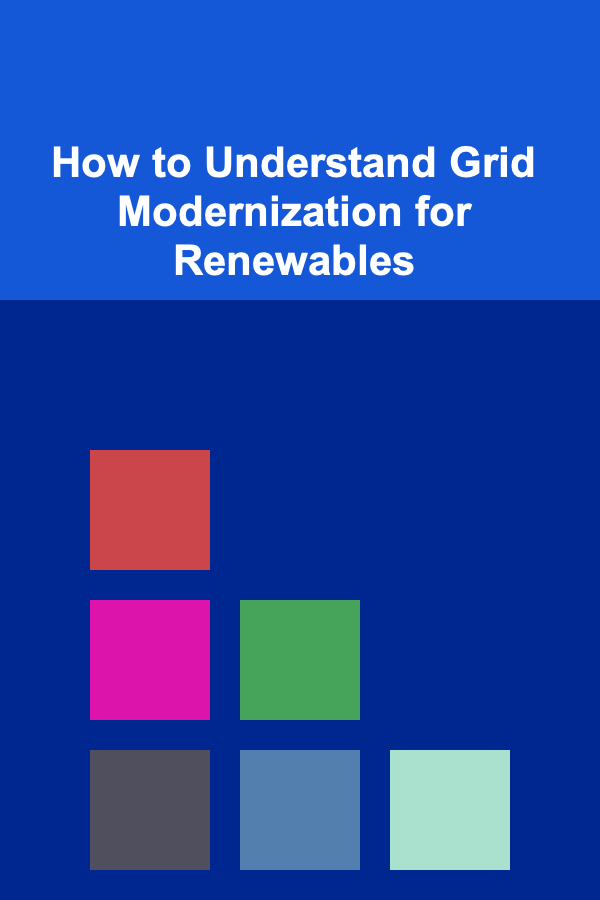
How to Understand Grid Modernization for Renewables
ebook include PDF & Audio bundle (Micro Guide)
$12.99$7.99
Limited Time Offer! Order within the next:

Grid modernization is one of the most important and transformative developments needed to enable the successful integration of renewable energy sources into our electricity grids. As the global demand for clean energy increases, the traditional electricity grid, which was designed around a centralized system of power generation, is being re-envisioned to accommodate more decentralized and intermittent energy sources such as solar, wind, and other renewable technologies.
Grid modernization involves updating the infrastructure, technologies, and processes that underpin the electricity grid to make it more adaptable, efficient, and capable of meeting the growing needs of renewable energy generation and consumption. This process is not only about upgrading hardware but also about creating intelligent systems that can manage, optimize, and store energy to ensure the grid operates effectively and reliably.
In this article, we will dive deep into the concept of grid modernization, exploring how it is essential for integrating renewable energy, the technologies and strategies that are involved, and the challenges that come with this transformative process.
What is Grid Modernization?
Grid modernization refers to the process of transforming the existing electrical grid infrastructure to make it more resilient, flexible, and efficient in accommodating new energy sources and technologies. Modernized grids are not just smarter in terms of automation and data usage, but also more resilient to extreme weather events, less prone to failures, and more capable of integrating renewable energy technologies.
Traditionally, the electricity grid was a one-way system that consisted of power plants sending electricity to consumers through transmission and distribution networks. However, with the growth of renewable energy sources, such as solar and wind, which are often intermittent and distributed, the grid must evolve to handle bidirectional flows of electricity, manage energy storage, and accommodate dynamic demand.
Key Features of Grid Modernization:
- Smart Meters and Sensors: These devices gather real-time data on energy use, demand, and grid health.
- Distributed Energy Resources (DERs): Integration of small-scale, decentralized energy sources like rooftop solar, small wind turbines, and batteries.
- Advanced Communication Systems: Communication technologies enable better interaction between power generation, storage, and consumption.
- Energy Storage: Technologies such as batteries and pumped hydro storage are needed to store energy generated by renewables for later use, particularly to balance supply and demand.
- Grid Automation and Control Systems: These systems use software to manage the grid and make real-time decisions on how to distribute energy.
The Role of Grid Modernization in Renewable Integration
The energy grid must evolve to address the unique characteristics of renewable energy. Unlike traditional fossil fuel-based power plants, renewable energy sources like solar and wind generate electricity intermittently and are highly variable. For example, solar power is only available when the sun shines, and wind power depends on wind speeds. This makes it difficult to rely on renewables as a sole source of energy unless the grid is able to handle fluctuations in supply and demand efficiently.
Grid modernization helps to bridge this gap in several ways:
2.1 Improved Integration of Intermittent Energy Sources
Modern grids use advanced forecasting tools, real-time data, and storage technologies to anticipate when renewable generation will peak or dip. By understanding when these fluctuations occur, grid operators can better balance supply and demand. This can also help in reducing curtailment, where excess renewable energy is wasted because the grid cannot absorb it.
2.2 Decentralized Energy Production and Distribution
With renewable energy sources distributed across various locations, from solar panels on rooftops to wind farms in remote areas, the traditional centralized grid model must shift to a more decentralized one. A modernized grid allows for bi-directional power flows, meaning that consumers can generate electricity (such as through rooftop solar) and send surplus power back to the grid.
2.3 Real-Time Monitoring and Control
With smart grids and advanced sensors, grid operators can monitor energy production and consumption in real time. This allows them to detect inefficiencies, identify faults, and adjust operations accordingly. Smart grid technologies enable better coordination between renewable energy production and demand, ensuring a reliable and stable supply of electricity.
2.4 Energy Storage and Demand Response
Energy storage systems, such as batteries, are an integral part of grid modernization for renewables. These systems allow excess energy generated during periods of high renewable output (e.g., a sunny afternoon or windy night) to be stored and released when demand exceeds supply. Additionally, demand response programs can shift energy usage during peak periods, reducing strain on the grid and promoting the use of renewable energy when it's abundant.
Technologies Powering Grid Modernization
Several technologies are driving the modernization of electrical grids, making them smarter and more capable of integrating renewable energy sources. These include:
3.1 Smart Grids
Smart grids are an upgrade over the traditional grid, allowing for two-way communication between energy providers and consumers. They leverage advanced metering infrastructure (AMI), sensors, and automation to improve grid reliability and optimize energy use. Smart grids provide a platform for integrating renewable energy by facilitating real-time data exchange, enabling demand-side management, and supporting distributed generation.
3.2 Advanced Energy Storage
Energy storage is a critical component of a modernized grid. Batteries, pumped hydro storage, and other storage technologies help smooth out the fluctuations in renewable generation. For example, solar power might peak during midday but decrease during evening hours. With energy storage, excess energy can be stored during the day and released in the evening, reducing the need for fossil fuel-based backup generation.
3.3 Microgrids
Microgrids are small, localized grids that can operate independently or in conjunction with the larger grid. They are ideal for integrating renewable energy sources, as they can manage and store energy locally, which reduces transmission losses and enhances resilience. Microgrids are particularly useful in remote areas or in regions where the grid infrastructure is not reliable.
3.4 Artificial Intelligence and Machine Learning
AI and machine learning are used to predict energy demand and supply, helping grid operators optimize their operations. These technologies can analyze vast amounts of data from sensors and weather forecasts to predict renewable energy output, grid load, and potential disruptions. By incorporating these predictions into their operations, grid operators can improve the efficiency and reliability of the grid.
3.5 Blockchain for Energy Trading
Blockchain technology has the potential to revolutionize the energy sector, particularly in decentralized energy trading. By enabling secure, transparent, and automated transactions, blockchain can help facilitate peer-to-peer energy trading, where individuals or businesses with renewable energy generation can sell their surplus to others, creating a more decentralized and flexible grid.
Challenges in Grid Modernization
While grid modernization offers immense potential for renewable energy integration, there are also significant challenges to address:
4.1 High Costs of Infrastructure Upgrades
Modernizing the grid requires substantial investment in new infrastructure, including advanced sensors, smart meters, and communication systems. These upgrades can be costly, and while they promise long-term benefits, the upfront costs can be a barrier for utilities and governments.
4.2 Cybersecurity Risks
As grids become more connected and reliant on digital technologies, they also become more vulnerable to cyberattacks. Securing the grid against potential threats is a top priority, as any disruption could lead to widespread power outages and damage to infrastructure. Building a resilient, secure grid requires robust cybersecurity measures.
4.3 Regulatory and Policy Challenges
In many regions, regulatory frameworks for grid modernization are still in development. Governments must create policies that encourage investment in renewable energy and grid modernization while also ensuring the stability and fairness of the energy market. Striking the right balance between innovation and regulation is critical for achieving a smooth transition to a renewable-powered grid.
4.4 Grid Interconnection and Standardization
With increasing numbers of decentralized and variable renewable energy sources, there is a need for standardized interconnection protocols and grid codes to ensure that different types of energy generation and storage systems can work together seamlessly. Harmonizing these standards across regions and countries will be a complex task.
4.5 Resistance to Change
The shift toward a modernized grid may face resistance from traditional energy providers, as well as from consumers who are accustomed to the old system. Overcoming this resistance requires public education, transparent communication, and financial incentives to encourage stakeholders to embrace the new grid technologies.
The Future of Grid Modernization
The future of grid modernization is closely tied to the continued growth of renewable energy sources. As the world shifts towards a cleaner energy future, grid modernization will be essential for ensuring a stable, reliable, and efficient energy system.
Some trends to watch in the future of grid modernization include:
- Decentralized energy systems: As more homes and businesses generate their own renewable energy, the grid will become increasingly decentralized, requiring greater coordination and flexibility.
- Greater use of AI and predictive analytics: The use of advanced analytics will become more sophisticated, enabling better optimization of energy flows, more efficient grid management, and reduced outages.
- Enhanced energy storage solutions: New advancements in energy storage technology, such as solid-state batteries and other innovations, will make it easier to store large amounts of renewable energy.
- Integration of electric vehicles (EVs): As EV adoption grows, vehicles may become an important source of grid flexibility, using vehicle-to-grid (V2G) technology to store and dispatch energy when needed.
Conclusion
Grid modernization is essential for the successful integration of renewable energy into our power systems. As renewable sources become more widespread, the grid must evolve to manage the challenges posed by their intermittency, variability, and decentralization. By leveraging technologies such as smart grids, energy storage, AI, and blockchain, we can build a more resilient, flexible, and efficient energy system. While the process of grid modernization comes with challenges, it offers the promise of a cleaner, more sustainable energy future.

How to Consider Pet Policies When Apartment Hunting: An Actionable Guide
Read More
How to Create a Financial Vision Board for Your Goals
Read More
How to Prevent Keyless Entry Break-ins in Your Home
Read More
How to Sell Pre-Trained Models for Passive Income
Read More
How to Reduce Food Waste to Combat Climate Change
Read More
How To Master Video Portfolio Building
Read MoreOther Products

How to Consider Pet Policies When Apartment Hunting: An Actionable Guide
Read More
How to Create a Financial Vision Board for Your Goals
Read More
How to Prevent Keyless Entry Break-ins in Your Home
Read More
How to Sell Pre-Trained Models for Passive Income
Read More
How to Reduce Food Waste to Combat Climate Change
Read More